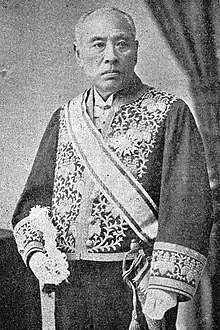Yamada Nobumichi
Yamada Nobumichi (山田 信道, 13 December 1833 – 11 March 1900) was a statesman in early Meiji period Japan.
Yamada Nobumichi 山田 信道 | |
|---|---|
 Yamada Nobumichi | |
| Born | December 13, 1833 Kumamoto, Higo Province, Japan |
| Died | March 11, 1900 (aged 66) |
| Nationality | Japanese |
| Occupation | politician, cabinet minister |
Biography
Yamada was born in Kumamoto Domain, Higo Province (present-day Kumamoto Prefecture). He was active in the Sonnō jōi movement, relocated to Satsuma Domain during the Bakumatsu period. Captured by security forces of the Tokugawa shogunate in 1863, he was sentenced to five years in prison.
After the Meiji restoration, Yamada was recruited into the new Meiji government and was assigned as governor of the short-lived Esashi Prefecture (now part of Akita and Iwate Prefectures in 1871.
Although Yamada was sympathetic to the grievances of the ex-samurai class and personally acquainted with many of the leaders of the Shinpūren Rebellion in his native Kumamoto, he remained loyal to the Meiji government throughout the uprising. He was rewarded with the governorships of Shimane Prefecture (1881–1888), Fukushima Prefecture (1888–1891), Osaka Prefecture (1891–1895) and Kyoto Prefecture (1895–1897). On June 5, 1896 he was elevated to the rank of baron (danshaku) in the kazoku peerage system.
Yamada was selected Minister of Agriculture & Commerce in the second Matsukata Masayoshi cabinet from 1897-1898. He subsequently served as chairman of the Board of Audit to his death in 1900. His grave is at the Aoyama Cemetery in Tokyo.
| Political offices | ||
|---|---|---|
| Preceded by Okuma Shigenobu |
Minister of Agriculture & Commerce Nov 1897 – Jan 1898 |
Succeeded by Itō Miyoji |